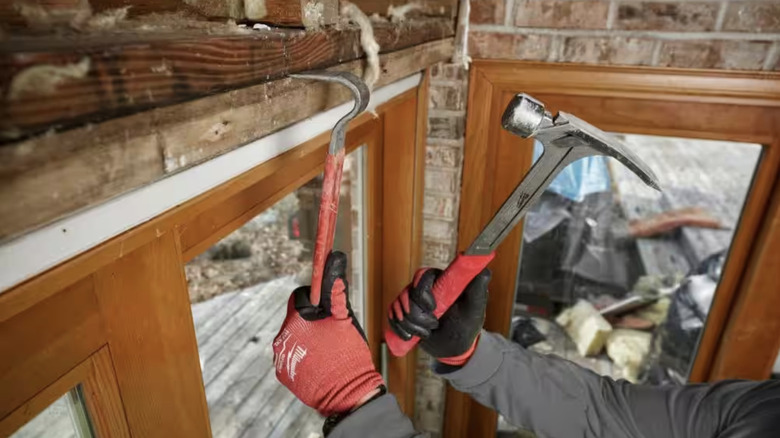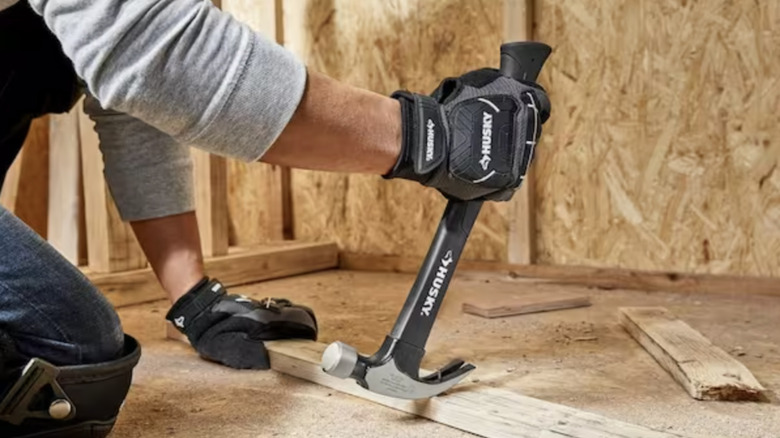Framing Hammer Vs. Claw Hammer: How To Pick The Right Tool For The Job
Though some tools may look the same, they can have slight differences that make specific jobs easier. For example, a brad nailer and a finish nailer are both nail guns but have different purposes. Likewise, there are many different styles of hammers. Some are so similar that you may find yourself looking into a toolbox one day feeling quite confused over which option is best for the job you're working on.
When comparing framing hammers and claw hammers, to the unknowing eye, they can look exactly the same. They both have a metal head and a handle big enough to comfortably grip. Additionally, they both have uses within carpentry and construction jobs, so you'll easily find them both on the job site. But that's about where the similarities end. Each hand tool has certain jobs that make removing nails, driving nails, and even framework easier for the user. Here's a breakdown of the hammers' unique characteristics and what you'll want to use each tool for.
What is a framing hammer used for?
As is given by its name, a framing hammer's main purpose is to help construct the framing of buildings. It's designed to be more powerful than the claw hammer, so it can hammer larger nails into wood to secure walls and other structures. You can use it while working with joists or rafters, and for ripping boards apart, but it's not recommended for trim, flooring, and finish nails due to its rugged nature.
A framing hammer has a few distinct features that help you differentiate it from the claw hammer. When picking up a framing hammer, the first thing you'll notice is its weight; at 16 to 22 ounces it's a bit heavier than a claw hammer. You'll want this type of weight with the bigger nails for building. You'll also notice that the handle is larger to give the worker more leverage and striking power. In terms of the claw, which is the back side of the head that removes nails, you'll notice it is straighter than a claw hammer, and better for grabbing and pulling apart boards.
In terms of price, different brands offer a variety of qualities and costs. Some can get as expensive as $300 like the Stiletto TiBone Hammer at Home Depot. However, when concerning tools needed for building and restoration projects, Harbor Freight sells some reasonably priced framing hammers for under $20 like the Pittsburgh Pro 22-ounce Solid Steel Framing Hammer which comes with high reviews from satisfied customers.
What is a claw hammer used for?
A claw hammer tends to be used for projects that don't need so much weight behind the blow, and they're better for when you need to pull out those pesky nails. Claw hammers aren't a downgrade from framing hammers, even though they do tend to run a bit cheaper and lighter. The weight of a claw hammer is usually around 10 to 16 ounces. Additionally, the handle is usually shorter, which allows the user to have more control over the tool's head placement when performing simple tasks. Imagine trying to use a heavy framing hammer just to pound in a small nail for a picture frame. You'll run the risk of missing and seriously denting the wall.
The most obvious difference is the shape of the claw itself. Claw hammers tend to be much more rounded to help give you the leverage you need to pull nails out of wood. If you're looking for a decently priced claw hammer, Harbor Freight has several to choose from with different handle materials. By far the most popular and highly rated hammer is the Pittsburgh 16-ounce Fiberglass Claw Hammer for only $6 and with over 1,700 reviews. Of course, every tool store is going to sell hammers, so you won't have a problem finding one to add as a toolbox essential.


